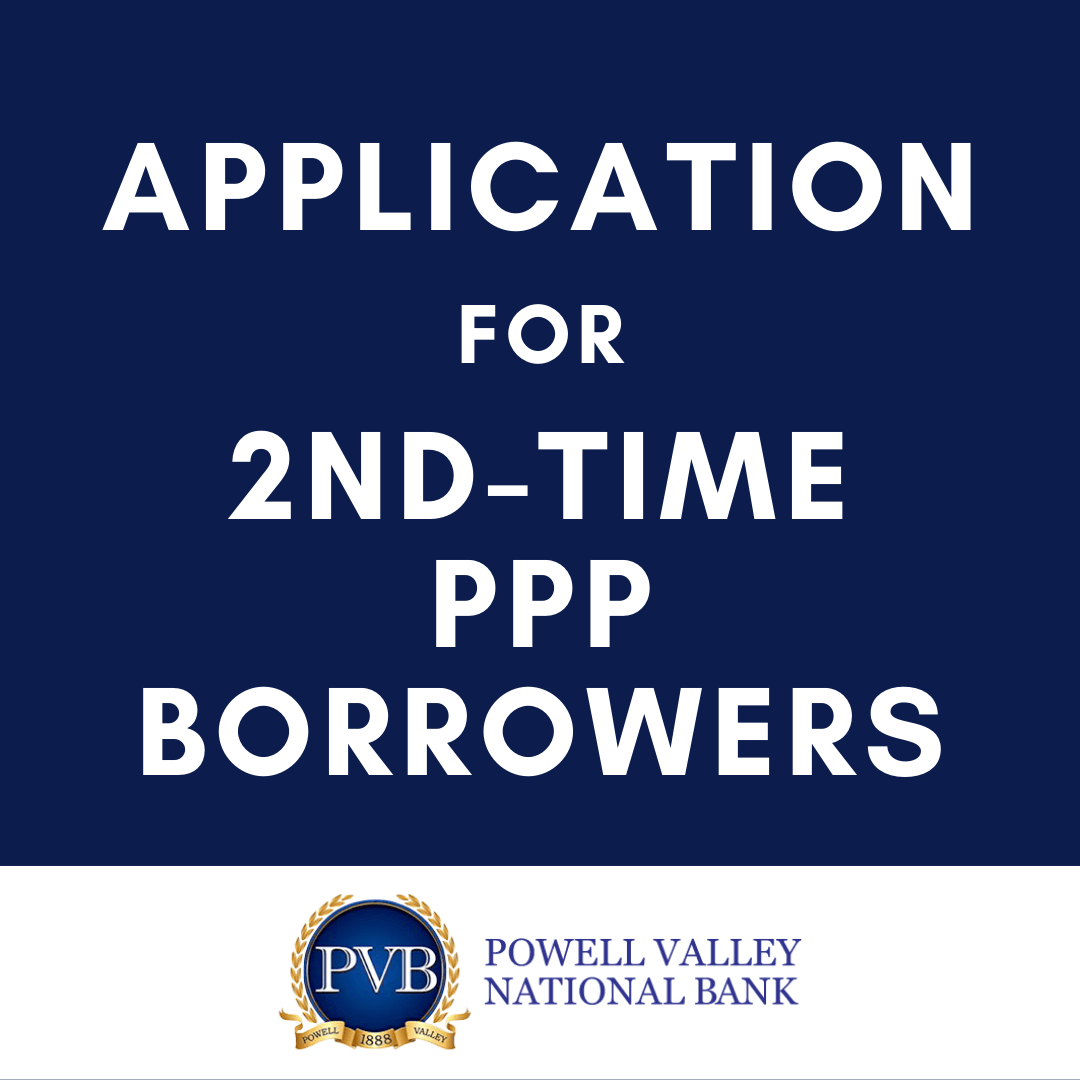The PPP Borrower Application Form below will need to be completed for all second-time borrowers. This new application was released January 8th.
All applicants should begin compiling the required information for submission.
We are awaiting a “go-live” date for when our institution will have access to begin submitting applications to the SBA.
Please monitor our website for further developments.
Once we have released the effective date, applicants will want to submit completed packages to their respective PVB Loan Officer.
PPP Second-Draw Borrower Application
Click here to access the application for first-time PPP borrowers.
Important Criteria
- For Borrowers whom will be requesting a 2nd draw, they must attest & certify to:
- They were in operation as of 02/15/2020, has not permanently closed, and was either an eligible self-employed individual, independence contractor, or sole proprietor w/no employees, or had employees for whom it paid salaries and payroll taxes or paid independent contractors, as reported on Form 1099-MISC;
- Current Economic uncertainty makes this loan request necessary to support the ongoing operations of the Applicant;
- The Applicant has realized a reduction in gross receipts in excess of 25% relative to the relevant comparison time period.
- For Loans >$150,000, Applicant has provided (will provide) documentation to the lender substantiating the decline in gross receipts.
- For Loans <$150,000, Applicant will provide documentation substantiating the decline in gross receipts upon or before seeking loan forgiveness for the Second Draw PPP Program Loan our upon SBA Request;
- The Applicant received a First Draw PPP Loan and, before the 2ND Draw Loan is disbursed, will have used the full amount (including any increase) of the First Draw PPP Loan only for eligible expenses;
- The funds will be used to retain workers & maintain payroll; or make payments for mortgage interest, rent, utilities, covered operations expenditures, covered property damage costs, covered supplier costs, & covered worker protection expenditures (PPE) as specified under the PPP Program rules;
- Loan forgiveness will be granted for the sum of documented payroll costs, covered mortgage interest payments, covered rent payments, covered utilities, covered operations expenses, covered property damage costs, covered supplier costs, & covered worker protection expenses (PPE), and not more than 40% of the forgiven amount may be for non-payroll costs.
- If required, the applicant will provide to the Lender and/or SBA documentation verifying the number of full time equivalent employees (FTE) on the Applicant’s payroll, as well as, the dollar amounts of eligible expenses for the covered period following the loan;
- The Applicant will not and has not received another 2nd Draw PPP Loan;
The Applicant has not and will not receive a Shuttered Venue Operator Grant from the SBA;
For purposes of calculating “average monthly payroll”:
The Applicant will have the option to utilize the average for either tax year 2019 or tax year 2020, excluding costs over $100,000 on an annualized basis.
- For Seasonal Businesses, the Applicant may elect to instead use average total monthly payroll for any 12-week period selected by the Applicant between 02/15/2019 and 02/15/2020, excluding costs over $100,000 on an annualized basis, as prorated for the period during which the payments are made or the obligation to make payments is incurred, for each employee;
- For New Businesses w/o 12-months of Payroll costs but that were in operation as of 02/15/2019 and 02/15/2020, average monthly payroll may be calculated based on the # of months in which payroll costs were incurred, excluding costs over $100,000 on an annualized basis for each employee, as prorated for the period during which the payments are made or the obligation to make the payments is incurred, for each employee;
- For Farmers & Ranchers that operate as a sole proprietorship or as an independent contractor, or who are eligible self-employed individuals and report farm income or expenses on a Schedule “F”, payroll costs, are computed using eligible payroll costs for employees, if any, plus the lessor of $100,000 and the difference between gross income and eligible payroll costs for employees as reported on Schedule “F”;
- For Applicants that file IRS Form 1040, Schedule “C”, payroll costs are computed using line 31 net profit amount, limited to $100,000, plus any eligible payroll costs for employees;
- For Applicants that are partnerships, payroll costs are computed using net earnings from self-employment of individual general partners, as reported on IRS Form 1065 K-1, reduced by section 179 expense deduction claimed, unreimbursed partnership expenses claimed, and depletion claimed on oil & gas properties, multiplied by 0.9235, that is not more than $100,000, plus any eligible payroll costs for employees.
When determining whether the Applicant experienced at least a 25% reduction in gross receipts:
- For loans >$150,000, the Applicant must:
- Identify the 2020 Quarter meeting this requirement, identify the reference quarter, and state the gross receipts amounts for both quarters, as well as, provide supporting documentation;
- For loans <$150,000, these fields are NOT required AND the Applicant only must certify that the Applicant has met the 25% gross receipts reduction at the time of application; however, before or upon seeking loan forgiveness (or upon SBA Request) the Applicant must provide documentation that identifies the 2020 quarter meeting this requirement, identifies the reference quarter, states the gross receipts amounts for both quarters, and supports the amounts provided.
For ALL Loans, the appropriate reference quarter depends upon on how long the Applicant has been in Operation.
- For ALL entities other than those satisfying the conditions set forth below:
- Applicants MUST demonstrate that gross receipts in any quarter 2020 were at least 25% lower than the same quarter in 2019.
- Alternatively, Applicants may compare annual gross receipts in 2020 with annual gross receipts in 2019;
- Applicants choosing to use annual gross receipts MUST enter “Annual” in the 2020 Quarter and Reference Quarter fields and, as required, documentation, must submit copies of annual tax forms substantiating the annual gross receipts reduction.
- For entities not in busines during the first and second quarters of 2019 but in operation during the third and fourth quarters of 2019, Applicants must demonstrate that gross receipts in any quarter of 2020 were at least 25% less than either the third or fourth quarter of 2019.
- For entities not in business during the first, second, and third quarters of 2019, but in operation during the fourth quarter of 2019, Applicants must demonstrate gross receipts in any quarter of 2020 were at least 25% less than the fourth quarter of 2019;
- For entities not in business during 2019, but in business as of 02/15/2020, Applicants must demonstrate that gross receipts in the second, third, or fourth quarter of 2020 were at least 25% less than the first quarter of 2020
- Applicants MUST demonstrate that gross receipts in any quarter 2020 were at least 25% lower than the same quarter in 2019.
Gross Receipts is defined as:
- All revenue in whatever form received or accrued (in accordance w/the entity’s accounting method) from whatever source, including from the sale of products, services, interest, dividends, rents, royalties, fees, or commission, reduced by returns and allowances.
- Generally, receipts are considered “total income” (or in the case of sole proprietors, “gross income”) plus“costs of goods sold” and excludes capital gains or losses as these terms are defined and reported on IRS tax return forms;
Gross Receipts do NOT include the following:
- Taxes collected for & remitted taxing authority if included in gross or total income, such as sales or other taxes collected from customers and excluding taxes levied on the concern or its employees;
- Proceeds from transactions between a concern and its domestic or foreign affiliates;
- Amounts collected for another by a travel agent real estate agent, advertising agent, conference management service provider, freight forwarder, or customs broker.
- All other items, such as subcontractor costs, reimbursements for purchases a contractor makes at a customer’s request, investment income, and employee-based costs such as payroll taxes, may not be excluded from gross receipts;
- Gross Receipts of a borrower must be aggregated with gross receipts of its affiliates;
For purposes of calculating Number of Employees:
- Sole Proprietors, self-employed individuals, and independent contractors should include themselves as employees
- The minimum # in the box “Employees” should = one
- For NAICS 72 or eligible news organizations, applicants may not exceed 300 employees per physical location
For purposes of reporting Year of Establishment:
Self employed individuals and independent contractors may enter “NA”
For purposes of reporting NAICS Code:
- Applicants must match the business activity code provided on their IRS income tax filings, if applicable.
All parties listed below are considered owners of the Applicant as well as “principals”:
- For a sole proprietorship, the sole proprietor;
- For a partnership, all general partners, and all limited partners owning 20% or more of the equity of the firm;
- For a corporation, all owners of 20% or more of the corporation;
- For limited liability companies, all members owning 20% or more of the company;
- Any Trustor (if the Applicant is owned by a trust).





